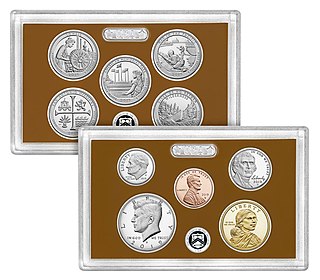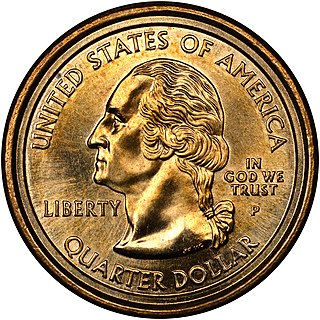Coins of the United States dollar - aside from those of the earlier Continental currency - were first minted in 1792. New coins have been produced annually and they comprise a significant aspect of the United States currency system. Circulating coins exist in denominations of 1¢, 5¢, 10¢, 25¢, 50¢, and $1.00. Also minted are bullion, including gold, silver and platinum, and commemorative coins. All of these are produced by the United States Mint. The coins are then sold to Federal Reserve Banks which in turn put coins into circulation and withdraw them as demanded by the United States economy.

The cent, the United States of America one-cent coin, often called the "penny", is a unit of currency equaling one one-hundredth of a United States of America dollar. It has been the lowest face-value physical unit of U.S. currency since the abolition of the half-cent in 1857. The first U.S. cent was produced in 1787, and the cent has been issued primarily as a copper or copper-plated coin throughout its history. Due to inflation, pennies have lost virtually all their purchasing power and are often viewed as an expensive burden to businesses, banks, government and the public in general.
Mint-made errors occur when coins are made incorrectly at the mint, including anything that happens to the coin up until the completion of the minting process. Mint error coins can be the result of deterioration of the minting equipment, accidents or malfunctions during the minting process, or interventions by mint personnel. Coins are inspected during production and errors are typically caught. However, some are inadvertently released into circulation. Modern production methods eliminate many errors and automated counters are effective at removing error coins. Damage occurring later may sometime resemble true mint errors. Error coins may be of value to collectors depending on the rarity and condition. Some coin collectors specialize in error coins.

A nickel is a five-cent coin struck by the United States Mint. Composed of cupronickel, the piece has been issued since 1866. Its diameter is 0.835 inches (21.21 mm) and its thickness is 0.077 inches (1.95 mm).

The Canadian five-cent coin, commonly called a nickel, is a coin worth five cents or one-twentieth of a Canadian dollar. It was patterned on the corresponding coin in the neighbouring United States. It became the smallest-valued coin in the currency upon the discontinuation of the penny in 2013. Due to inflation, the purchasing power of the nickel continues to drop and currently the coin represents less than 0.5% of the country's lowest minimum hourly wage.

The United States large cent was a coin with a face value of 1/100 of a United States dollar. Its nominal diameter was 11⁄8 inch (28.57 mm). The first official mintage of the large cent was in 1793, and its production continued until 1857, when it was officially replaced by the modern-size one-cent coin.
This glossary of numismatics is a list of definitions of terms and concepts relevant to numismatics and coin collecting, as well as sub-fields and related disciplines, with concise explanations for the beginner or professional.
This table represents the mintage figures of circulating coins produced by the United States Mint since 1887. This list does not include formerly-circulating gold coins, commemorative coins, or bullion coins. This list also does not include the three-cent nickel, which was largely winding down production by 1887 and has no modern equivalent.
A type set is a coin collection based on coin design or type. Traditional collections consist of all dates within a series such as state quarters or Lincoln cent.

The 1974 aluminum cent was a one-cent coin proposed by the United States Mint in 1973. It was composed of an alloy of aluminum and trace metals, and it was intended to replace the predominantly copper–zinc cent due to the rising costs of coin production in the traditional bronze alloy. Of the 1,571,167 coins struck in anticipation of release, none were released into circulation. To encourage congressional support for the new alloy, the Mint distributed several examples to U.S. Congressmen. When the proposed aluminum cent was rejected, the Mint recalled and destroyed those coins.

Coin roll hunting is the hobby of searching and sorting coinage pulled from circulation for collectible coins. This is achieved through obtaining rolled coin, boxed coin, or bagged coin from banks and credit unions. A variant of this practice involves banknotes and is carried out in essentially the same fashion, normally to search for unusual serial numbers, star notes, and misprints.

The Coronet large cent was a type of large cent issued by the United States Mint at the Philadelphia Mint from 1816 until 1857.

The Lincoln cent is a one-cent coin that has been struck by the United States Mint since 1909. The obverse or heads side was designed by Victor David Brenner, as was the original reverse, depicting two stalks of wheat. The coin has seen several reverse, or tails, designs and now bears one by Lyndall Bass depicting a Union shield. All coins struck by the United States government with a value of 1⁄100 of a dollar are called cents because the United States has always minted coins using decimals. The penny nickname is a carryover from the coins struck in England, which went to decimals for coins in 1971.
The coinage metals comprise those metallic chemical elements and alloys which have been used to mint coins. Historically, most coinage metals are from the three nonradioactive members of group 11 of the periodic table: copper, silver and gold. Copper is usually augmented with tin or other metals to form bronze. Gold, silver and bronze or copper were the principal coinage metals of the ancient world, the medieval period and into the late modern period when the diversity of coinage metals increased. Coins are often made from more than one metal, either using alloys, coatings (cladding/plating) or bimetallic configurations. While coins are primarily made from metal, some non-metallic materials have also been used.
US error coins are error coins produced by the US government. There are three categories of error coins as provided by the American Numismatic Association. Metal usage and striking errors referred to widely as planchet errors, die errors, and mint striking errors. This does not include the varieties that the US Mint has issued over the years.

The ring cent or holey cent was a one-cent pattern coin first struck in various compositions and designs between 1850 and 1851 as part of an experiment on producing a cent with a reduced weight and diameter, as the rising price of copper had caused cents to cost more than their face value to produce. Many varieties exist, with differing designs as well as differing compositions, including billon (standard), aluminum, copper, cupronickel, nickel silver, nickel, silver, and white metal.

The United States Mint Proof Set, commonly known as the Proof Set in the United States, is a set of proof coins sold by the United States Mint. The proof set is popular with coin collectors as it is an affordable way to collect examples of United States coinage in proof condition.
The United States Uncirculated Coin Set, known as the Uncirculated Set or Mint Set in the United States, is an annual coin set sold by the United States Mint. The set is marketed towards coin collectors as a way to obtain circulation coins in mint condition.

The 1942 experimental cents were pattern coins struck by the United States Mint to test alternative compositions for the penny.

The 2000 Sacagawea dollar – Washington quarter mule is an error coin featuring the obverse of a Washington quarter and the reverse of a Sacagawea dollar struck on a gold-colored dollar coin planchet. It is one of the first known authentic mule coins to be released into circulation by the United States Mint.













